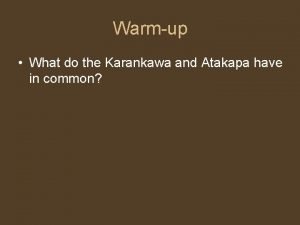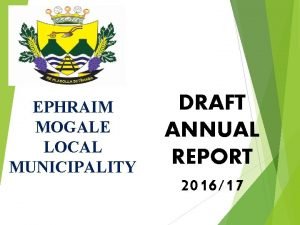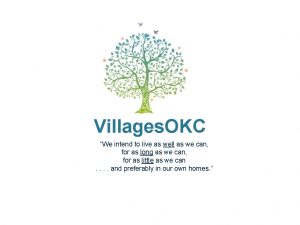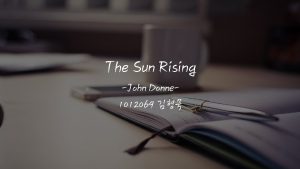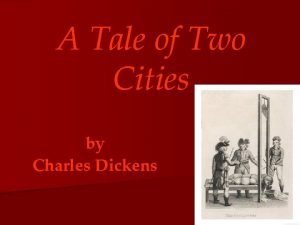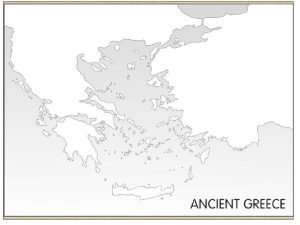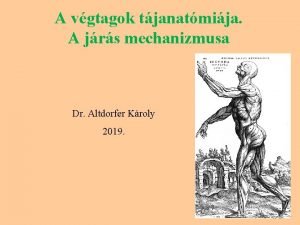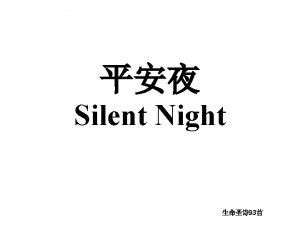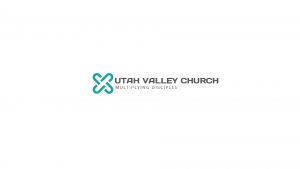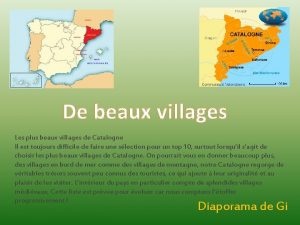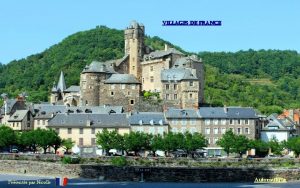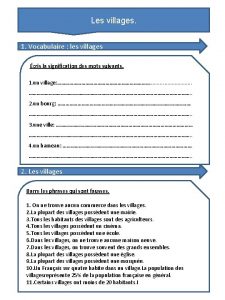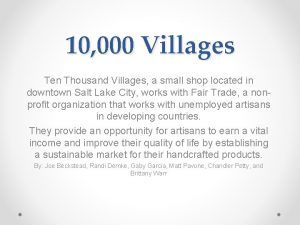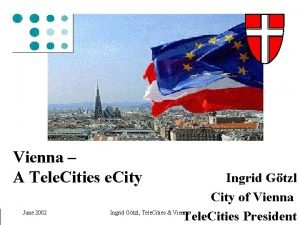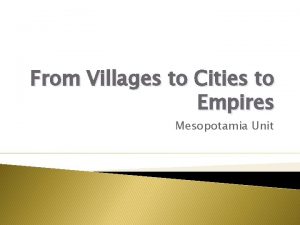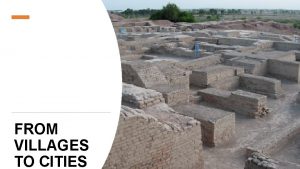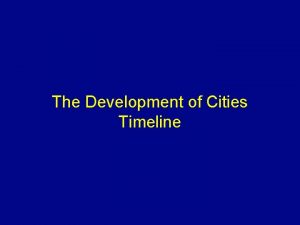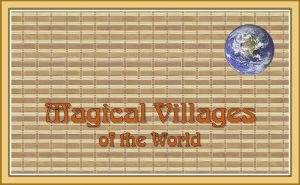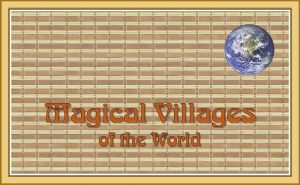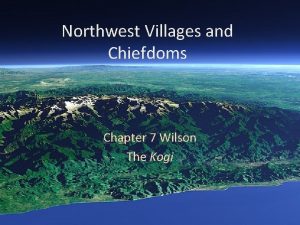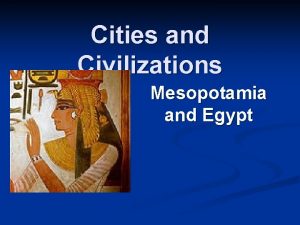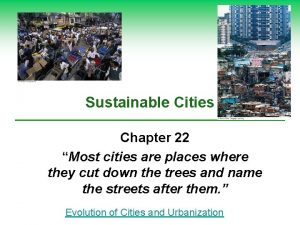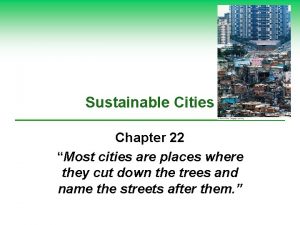Chapter 11 Cities and Villages All cities goroda

























- Slides: 25

Chapter 11. Cities and Villages All cities (goroda) and towns of Russia Urbanization rate: USA 81%, Russia 74% TABLE 11. 1. The Soviet Typology of Settlements Settlement type Largest city Large city Medium city Small city Town Big village Regular village Russian name Population size % of total population 1994 2010 Krupnejshij gorod Krupnyj gorod Srednij gorod Malyj gorod Poselok gorodskogo tipa Selo 1– 10 million 17% 19. 7% 100, 000– 1 million 50, 000– 100, 000 20, 000– 50, 000 30% 8% 8% 29. 4% 7. 6% 10. 8% 5, 000– 20, 000 9% 5. 5% 1, 000– 5, 000 20% 21% Derevnya <1, 000 7% 6% This slide is a supplement to A Geography of Russia and Its Neighbors, Second Edition by Mikhail S. Blinnikov. Copyright © 2021 The Guilford Press.

Population of the top cities: USA vs. Russia (thousands, 2014) USA Ø New York Ø Los Angeles Ø Chicago Ø Houston Ø Philadelphia Ø Phoenix Ø San Antonio Ø San Diego • • • 8, 491 3, 929 2, 722 2, 240 1, 560 1, 537 1, 437 1, 381 RUSSIA Ø Moscow Ø St. Petersburg Ø Novosibirsk Ø Yekaterinburg Ø Nizhniy Novgorod Ø Kazan Ø Chelyabinsk Ø Omsk 12, 198 5, 192 1, 567 1, 428 1, 268 1, 206 1, 183 1, 174 Russia has one primary city (Moscow) that dwarfs all the rest – over 12 million No cities of 3– 4 million High concentration of power and money in one place (think: Paris, France) Think: what do urban areas over 1 million have that most smaller cities don’t? • Subway (e. g. , Metro in Moscow) • World-class universities • World-class hospitals • Major governmental offices • World-class stadiums This slide is a supplement to A Geography of Russia and Its Neighbors, Second Edition by Mikhail S. Blinnikov. Copyright © 2021 The Guilford Press.

The oldest city in the European part? Chersonesus, Crimea (est. 6 th century BC) Derbent in Dagestan may be even older 15 “million+” cities in Russia in 2017 (Table 11. 3) How did Soviet cities differ from US cities? Many are much older – inherited medieval patterns • • • Like in Europe in general; few, if any, skyscrapers (Moscow is an exception, St. Petersburg has one, but tallest in Europe) Centrally planned in the Soviet times – e. g. , microrayony concept Little sprawl: Urban Growth Boundary well defined and enforced Wider streets, larger blocks (typically 150 m + long) Larger parks with more trees Much higher residential density (x 10 in some cases) Mass transit, not car, as the main mode of transportation Little racial or ethnic segregation existed in the Soviet-era cities (some begins to appear now) Note: governmental officials were segregated from the “common masses” on dachas and in the exclusive apartment buildings and administrative offices This slide is a supplement to A Geography of Russia and Its Neighbors, Second Edition by Mikhail S. Blinnikov. Copyright © 2021 The Guilford Press.

Typical transportation options in Russian cities: • Buses • Street car (tramway) • Trolleybus –increasingly replaced with electric buses • Marshrutka (small bus making stops on demand) • Taxis and ride-sharing (Yandex taxi, Citimobil) • Car sharing apps Moscow Metro is one of the busiest in the world and arguably the most beautiful • metro. ru • 12 million commuters/day! • Convenient connections everywhere • Single zone tickets, touch and go • Trains run every 1– 2 minutes in rush hour, from 5: 30 am until about 1 am • About 10 new stations have been opened per year in recent years • Also combined with above-ground trains in the city core This slide is a supplement to A Geography of Russia and Its Neighbors, Second Edition by Mikhail S. Blinnikov. Copyright © 2021 The Guilford Press.

Suburban trains – elektrichka extend options for about 150 km outward Map of Moscow zones (Fig. 11. 8) • Historic core about 5 km in diameter and centered on the Kremlin • Old residential • Industrial rust belt • Sleeping quarters for the masses Look of an older neighborhood from 1960 s: Moscow, 5 floors, kruschevki Mikrorayon – concept of 1970 s, concrete panels, 9– 16 floors, self-contained with everything one needs (schools, clinics, shops inside) Mikrorayony in Saratov (pop. 836, 000) View of Biysk (pop. 220, 000) combines both concrete panel housing and wood village-type homes Modern residential: Orekhovo-Borisovo, Moscow, where the author grew up (300, 000 people) Modern housing is no longer panels, it is poured concrete and sometimes brick, stronger and more durable Modern elite residential: Moscow suburbs, average house may be comparable to US, 4– 5 bedrooms, 200 m 2 or more, gated communities are common This slide is a supplement to A Geography of Russia and Its Neighbors, Second Edition by Mikhail S. Blinnikov. Copyright © 2021 The Guilford Press.

Urban vs. rural divide General trend away from countryside since 19 th century Pull factors: Education, marriage, employment quotas Push factors: tough life on state farms Propiska – Soviet-era residency quota permit system in the biggest cities to slow down urbanization Now replaced with less stringent registration (people can now choose to voluntarily move) High concentration of workers encouraged by the ministries – encouraged urbanization Monocities formed – a single factory dominates (a few hundred exist) • • • Best life today – in the largest 10 or so Huge opportunity to develop medium-size cities, under 1 million Most small cities are “beyond repair”? Medium city example: Murom in Vladimir oblast (110, 000) Medium-small city example: Kasimov in Ryazan oblast (population 25, 000), had 20 factories in the Soviet period, 2 left now This slide is a supplement to A Geography of Russia and Its Neighbors, Second Edition by Mikhail S. Blinnikov. Copyright © 2021 The Guilford Press.

Suzdal in Vladimir oblast is a historic city (only 12, 000 pop. ), survives on organized bus tourism Village life • Peasants made up 85% in 1900; rural population 27% in 2000 • Communal origins (+serfdom) selo vs. derevnya • Soviet villages – impact of collectivization • Today 3 forms of village life • “Classical village” based on kolkhoz farm (+forestry) • Individual farmers (new, however traditional hutor in Ukraine ) • Urban residents using village as summer home Images of Russian countryside This slide is a supplement to A Geography of Russia and Its Neighbors, Second Edition by Mikhail S. Blinnikov. Copyright © 2021 The Guilford Press.

This slide is a supplement to A Geography of Russia and Its Neighbors, Second Edition by Mikhail S. Blinnikov. Copyright © 2021 The Guilford Press.

This slide is a supplement to A Geography of Russia and Its Neighbors, Second Edition by Mikhail S. Blinnikov. Copyright © 2021 The Guilford Press.

This slide is a supplement to A Geography of Russia and Its Neighbors, Second Edition by Mikhail S. Blinnikov. Copyright © 2021 The Guilford Press.

This slide is a supplement to A Geography of Russia and Its Neighbors, Second Edition by Mikhail S. Blinnikov. Copyright © 2021 The Guilford Press.

This slide is a supplement to A Geography of Russia and Its Neighbors, Second Edition by Mikhail S. Blinnikov. Copyright © 2021 The Guilford Press.

This slide is a supplement to A Geography of Russia and Its Neighbors, Second Edition by Mikhail S. Blinnikov. Copyright © 2021 The Guilford Press.

This slide is a supplement to A Geography of Russia and Its Neighbors, Second Edition by Mikhail S. Blinnikov. Copyright © 2021 The Guilford Press.

This slide is a supplement to A Geography of Russia and Its Neighbors, Second Edition by Mikhail S. Blinnikov. Copyright © 2021 The Guilford Press.

This slide is a supplement to A Geography of Russia and Its Neighbors, Second Edition by Mikhail S. Blinnikov. Copyright © 2021 The Guilford Press.

This slide is a supplement to A Geography of Russia and Its Neighbors, Second Edition by Mikhail S. Blinnikov. Copyright © 2021 The Guilford Press.

This slide is a supplement to A Geography of Russia and Its Neighbors, Second Edition by Mikhail S. Blinnikov. Copyright © 2021 The Guilford Press.

This slide is a supplement to A Geography of Russia and Its Neighbors, Second Edition by Mikhail S. Blinnikov. Copyright © 2021 The Guilford Press.

This slide is a supplement to A Geography of Russia and Its Neighbors, Second Edition by Mikhail S. Blinnikov. Copyright © 2021 The Guilford Press.

This slide is a supplement to A Geography of Russia and Its Neighbors, Second Edition by Mikhail S. Blinnikov. Copyright © 2021 The Guilford Press.

This slide is a supplement to A Geography of Russia and Its Neighbors, Second Edition by Mikhail S. Blinnikov. Copyright © 2021 The Guilford Press.

This slide is a supplement to A Geography of Russia and Its Neighbors, Second Edition by Mikhail S. Blinnikov. Copyright © 2021 The Guilford Press.

This slide is a supplement to A Geography of Russia and Its Neighbors, Second Edition by Mikhail S. Blinnikov. Copyright © 2021 The Guilford Press.

This slide is a supplement to A Geography of Russia and Its Neighbors, Second Edition by Mikhail S. Blinnikov. Copyright © 2021 The Guilford Press.
 The jumano built villages and grew crops near the
The jumano built villages and grew crops near the Les beaux villages de france
Les beaux villages de france Markook mandal villages list
Markook mandal villages list Villages de pierres et d eau
Villages de pierres et d eau Freight villages
Freight villages Nagalgidda mandal villages list
Nagalgidda mandal villages list Iron tools and agriculture
Iron tools and agriculture Villages medical centre
Villages medical centre Ephraim mogale local municipality villages
Ephraim mogale local municipality villages Villages okc
Villages okc Name three lines
Name three lines From fog to endless night figure of speech
From fog to endless night figure of speech She's all states and all princes i
She's all states and all princes i A tale of two cities summary
A tale of two cities summary Adriatic sea ancient greece map
Adriatic sea ancient greece map Love ever hurt never
Love ever hurt never Interventi sociali rivolti alla persona
Interventi sociali rivolti alla persona Above all powers
Above all powers I work all day i work all night to pay the bills
I work all day i work all night to pay the bills All-to-all personalized communication
All-to-all personalized communication Sistem all in all out
Sistem all in all out Carpi volare
Carpi volare Silent night holy night all is calm
Silent night holy night all is calm 馮定華神父2020
馮定華神父2020 All of you is more than enough for all of me
All of you is more than enough for all of me No power of hell, no scheme of man bible verse
No power of hell, no scheme of man bible verse
